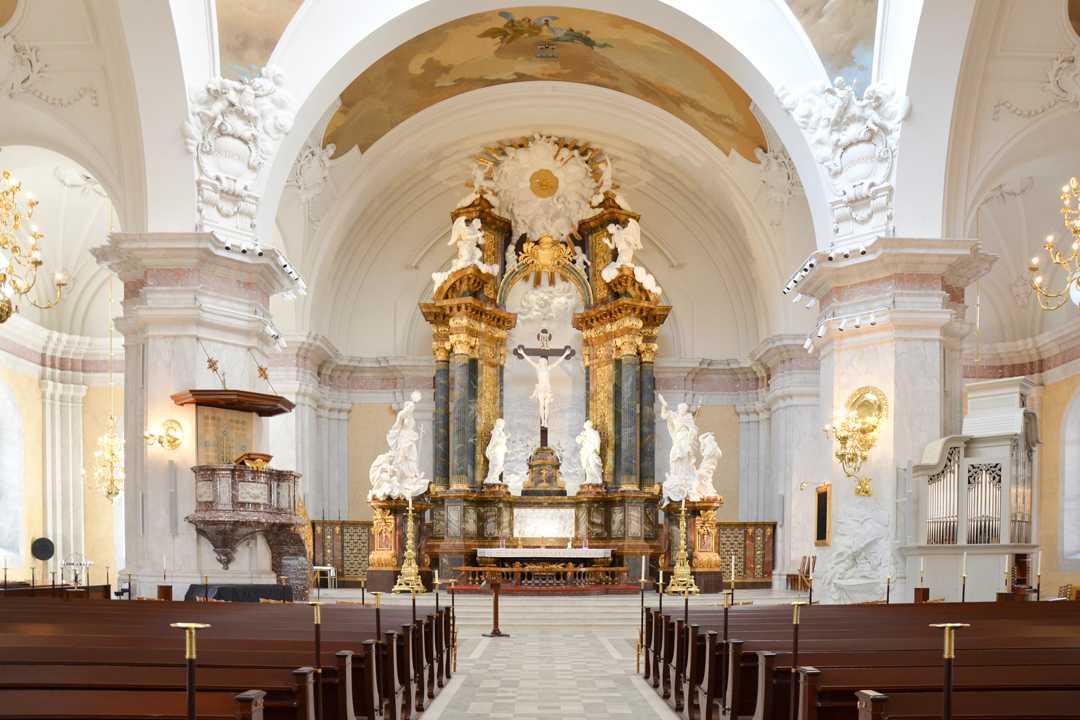Gustav Vasa Kyrka refurbished with d&b
- Details

The Gustav Vasa Kyrka was designed by August Lindegren and completed in 1906, with a capacity of up to 1,200 worshippers, generations of whom have no doubt marvelled at the lavishly decorated marble surfaces, and soaring arches. They also can’t have failed to notice the remarkable reverberation time.
Jacob Julin of Soundcop, the company brought in to solve the church’s intelligibility woes, says, “The acoustics was the biggest challenge. When we started, the hall had an acoustic reverberation of six seconds, so that was of course an issue.”
Later however, following the building’s refurbishment, including new treatments to the floor and walls, that reverb time had risen to seven-and-a-half seconds. Julin continues, “The worst of the reverberation is between 300-500 Hz, so it is possible to improve it with a little bit of system trim, but the reverberation is very long in full frequency as well.”
Representing Svenska Kyrkan, facilities manager Urban Paulander says: “What we wanted was a system which would make speech and music as clear as possible for all the listeners in all areas of the church.”
d&b xC-Series column loudspeakers, which SoundCop had used successfully in Stockholm’s Maria Magdalena church the year before, were well suited to the task. Purchased via ARVA Trading, the d&b audiotechnik distributor for Sweden, their cardioid dispersion performance is key to reducing unwanted reflections and maximising intelligibility in spaces like this. Julin says: “The 24C was the obvious choice. I was worried that they wouldn’t cover the 19m throw distance to the delays, so that was a nervous point, but it worked. It worked straight away.”
The finished installation consists of a left/right PA system, with one 24C cabinet per side, plus two of the tiny d&b 4S cabinets pointing in towards the altar. Then there are 24Cs pointing the same way as the PA, and two 16C point back to the presenter’s position for foldback.
“On one of the pillars there is an organ that is totally in the way of everything,” says Julin. “If we put a speaker there, no-one behind it would hear anything. So we made 80cm wall-mount arms to hold the speakers out on each side of the organ.”
Around the pillars 24C, 24C-E plus 4S cabinets from the xS-Series, cover from the balconies, with further 4S cabinets providing under-balcony fill, and further 16Cs for delays on the pillars further down the room. In addition, a separate system of 16Cs is installed in one of the side-chapels.
The system is powered by eight d&b 10D amplifiers, with two DS10 network bridges providing the digital networking via a Yamaha Rio3224 I/O unit. “Every speaker is on its own channel to allow us to time align everything. There are two DS10s to get the audio from Yamaha and Q-Sys via DANTE and distribute it via AES to the amps.”
The project’s aesthetic demands also made for a complex cabling installation, with Julin and his team running everything through precisely cut steel conduit, carefully tracing the ornate architectural features. “As there were a great deal of small angles needed for this, we had to more or less become plumbers to do it.” he says.
A QSC Q-SYS Core 500i processor gives connection to two touch screens - one by the priest’s position, allowing them to select their own microphone, and another at front-of-house. “Here we have made very good use of the d&b plug-in for Q-SYS,” says Julin. “It gives the user easy control of zones, by selecting areas of the room on a plan view map on the touchscreen. This mutes or unmutes the different areas.”
In total, around 30 loudspeakers are installed, mostly mounted on or near the two foremost pillars. Two Q-SYS Page Stations are included for use in emergency evacuations, while a Yamaha QL1 digital console presides over the system at the front-of-house control position.
(Jim Evans)
















